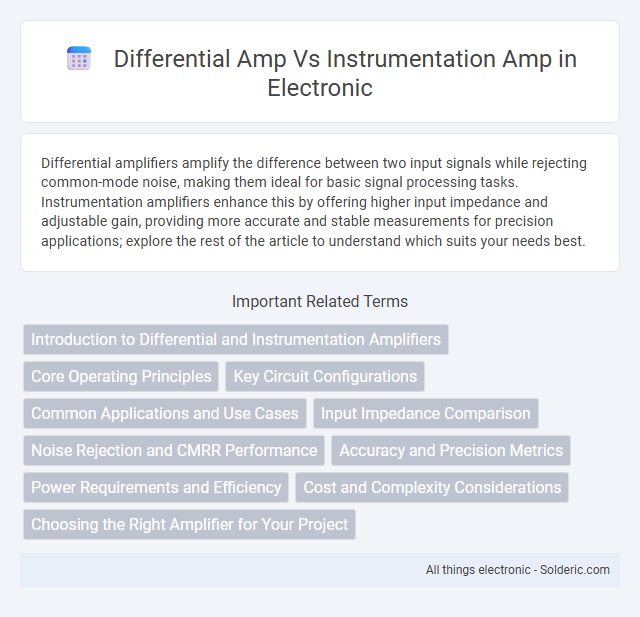Differential amplifiers amplify the difference between two input signals while rejecting common-mode noise, making them ideal for basic signal processing tasks. Instrumentation amplifiers enhance this by offering higher input impedance and adjustable gain, providing more accurate and stable measurements for precision applications; explore the rest of the article to understand which suits your needs best.
Comparison Table
| Feature | Differential Amplifier | Instrumentation Amplifier |
|---|---|---|
| Purpose | Amplifies difference between two input signals | High-precision amplification of low-level differential signals |
| Input Impedance | Moderate | Very High |
| Gain | Fixed or adjustable with external components | Precisely adjustable gain via resistor network |
| Common-Mode Rejection Ratio (CMRR) | Moderate to High | Very High (typically > 80 dB) |
| Noise Performance | Moderate | Low noise, optimized for sensitive measurements |
| Complexity | Simple, fewer components | More complex, multiple op-amps internally |
| Applications | Basic signal conditioning | Medical instrumentation, strain gauges, sensor interfacing |
| Cost | Lower | Higher due to complexity and precision |
Introduction to Differential and Instrumentation Amplifiers
Differential amplifiers amplify the voltage difference between two input signals while rejecting common-mode noise, essential for precise signal processing in noisy environments. Instrumentation amplifiers build on differential amplifiers by providing high input impedance and adjustable gain, making them ideal for accurate, low-level signal amplification in biomedical and industrial applications. Their design ensures minimal signal distortion and enhanced common-mode rejection ratio (CMRR), critical for measurement accuracy.
Core Operating Principles
A differential amplifier amplifies the voltage difference between two input signals, rejecting any voltage common to both inputs, primarily using transistor pairs or operational amplifiers. An instrumentation amplifier builds on the differential amplifier's principle by incorporating input buffer stages, providing high input impedance and precise gain control through resistor networks. The core advantage of instrumentation amplifiers is their enhanced accuracy and stability in measuring small differential signals amidst high common-mode noise.
Key Circuit Configurations
Differential amplifiers typically use a pair of transistors or operational amplifiers arranged to amplify the voltage difference between two inputs, making them suitable for rejecting common-mode signals. Instrumentation amplifiers build upon the differential amplifier configuration by incorporating multiple op-amps with high input impedance and precise gain control, enhancing accuracy and stability in low-level signal measurement. Your choice between these key circuit configurations depends on the need for input impedance, gain accuracy, and noise rejection in your application.
Common Applications and Use Cases
Differential amplifiers are commonly used in audio equipment and signal conditioning to amplify the difference between two input signals while rejecting noise. Instrumentation amplifiers excel in precision measurement applications such as medical devices, strain gauge sensors, and data acquisition systems due to their high input impedance and excellent common-mode rejection ratio (CMRR). Both amplifiers are crucial in environments requiring accurate differential signal amplification, but instrumentation amps are preferred when stable gain and low offset are critical.
Input Impedance Comparison
Differential amplifiers typically have moderate input impedance, ranging from kilo-ohms to mega-ohms, which can load down high-impedance signal sources. Instrumentation amplifiers boast significantly higher input impedance, often in the order of mega-ohms to giga-ohms, protecting your sensitive measurement signals from loading effects and signal distortion. This higher input impedance makes instrumentation amplifiers ideal for accurately amplifying low-level signals from sensors and transducers.
Noise Rejection and CMRR Performance
Instrumentation amplifiers exhibit superior noise rejection and higher common-mode rejection ratio (CMRR) compared to differential amplifiers due to their design with multiple op-amps and precise resistor matching. The enhanced CMRR in instrumentation amps makes them ideal for measuring low-level signals in noisy environments, ensuring your signal integrity is maintained. Differential amplifiers, while simpler, typically have lower CMRR and noise rejection capabilities, making them less effective for high-precision applications.
Accuracy and Precision Metrics
Differential amplifiers offer good accuracy by amplifying the voltage difference between two inputs while rejecting common-mode signals, but instrumentation amplifiers excel in precision with higher input impedance, lower offset voltage, and significantly improved common-mode rejection ratio (CMRR). Instrumentation amplifiers are designed to maintain steady gain and minimize noise, ensuring your measurements remain highly accurate and stable across varying conditions. When precise signal amplification is critical, particularly in biomedical or sensor applications, instrumentation amplifiers provide superior accuracy and precision metrics compared to basic differential amplifiers.
Power Requirements and Efficiency
Differential amplifiers typically consume less power due to their simpler design compared to instrumentation amplifiers, which incorporate multiple stages for higher precision and noise rejection. Instrumentation amplifiers demand more power to maintain their high input impedance and accurate gain, impacting overall efficiency in battery-operated or low-power applications. Your choice should balance power efficiency against the need for precision and noise performance in the specific circuit environment.
Cost and Complexity Considerations
Differential amplifiers offer a simpler design with lower component count, making them more cost-effective for basic signal amplification tasks. Instrumentation amplifiers, while more complex due to multiple op-amps and precision resistors, provide superior accuracy and input impedance, which can justify higher costs in precision measurement applications. Your choice depends on balancing budget constraints with the need for measurement precision and signal integrity.
Choosing the Right Amplifier for Your Project
Selecting the right amplifier depends on the application's precision and noise rejection requirements; instrumentation amplifiers provide high input impedance and excellent common-mode rejection, making them ideal for accurate low-level signal measurement in medical devices and industrial sensors. Differential amplifiers are simpler and cost-effective for applications with less stringent noise rejection needs or single-ended signals, such as audio processing or basic voltage difference measurements. Evaluating factors like input impedance, gain accuracy, and common-mode rejection ratio ensures optimal performance and reliability in your specific project.
differential amp vs instrumentation amp Infographic

 solderic.com
solderic.com